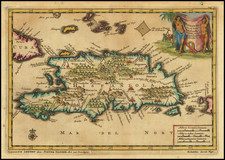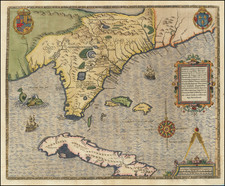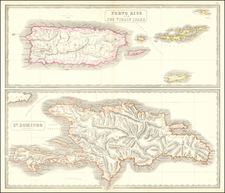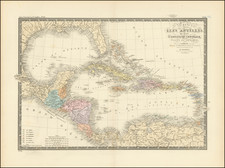Exceptional Original Color Example of this Separately-Issued Map of Saint Domingue Based on Jesuit Manuscript Sources
Finely detailed map of Saint Domingue by the renowned French mapmaker Jean-Baptiste Bourguignon d’Anville. This is a separately-issued example of the map, which was also used as a book illustration; the present state, without a page number, is the rarer of the two.
The map shows the western portion of the island of Hispaniola, known as Saint Domingue. As the cartouche explains, this is the portion of the island controlled by France. The other, eastern, side of the island, known as Santo Domingo, was then under Spanish control. Cuba just peeks out of the top left corner, to the northwest of Saint Domingue.
The island itself is heavily labeled with settlements, which are concentrated along the coastline. These include Cap Francais, in the northeast, which was then the capital. Initially it was known as Cap Francois, as it is written here, and later as Cap Francais and today as Cap-Haïtien. Known as the “Paris of the Antilles,” Cap Francais was eclipsed when Port-au-Prince, in the deep bay in western Saint Domingue, became the capital in 1770.
There are also many rivers marked, along with notes as to the fertility or infertility of certain areas for agriculture. For example, La Gonave, a large island in the west, is labeled as “inculte et sterile,” or uncultivated and sterile.
The title, in the upper left, is contained within an ornate and remarkable cartouche. In addition to the curling frame, with delicate shell cusps and floral accents, there are two men, one on either side of the cartouche. These are French colonial settlers and both carry rifles. Behind the man to the left is a ship, ready to carry Saint Domingue’s harvests away for profit; the man to the right stands in front of a house, showing the prosperity and domesticity of this rewarding colony.
Of course, the cartouche hides the reason for the colony’s prosperity. Although initially colonized by the Spanish, the French took over the western third of the island of Hispaniola in 1697 with the Treaty of Rijswijk, only three decades before this map was drawn. As in the rest of the Caribbean, they developed large-scale plantations worked by enslaved Africans, with coffee plantations in the interior and sugar on the northern plains. The slave regime in Saint Dominque is considered by scholars as one of the most extreme. Slave mortality was high and violence common; the French imported over 800,000 men and women to the colony, practically double the total number imported to North America. This economic system built on the forced labor of thousands made Saint Domingue the most lucrative colony in the world.
D'Anville was well known for being the most erudite and meticulous mapmaker of his time. He was not content to reprint the work of others; rather he had to study all available materials and then make his own representations from scratch. In this case, he identifies a source that was particularly helpful to him in making this map, the maps of “P. Le Pers, Jesuite.”
Father Jean-Baptiste le Pers (1675-1735) was a Jesuit priest and historian. He served as a missionary in Saint Domingue and kept meticulous notes about life there. These notes then served as the basis for Father Pierre François Xavier de Charlevoix’s Histoire de L’Isle Espagnole ou de S. Domingue, the first volume of which was published in Paris in 1730.
D’Anville had access to le Pers’ manuscript materials before they went to press, as he prepared this map to be included with the second volume of the book, published in 1731. Most surviving examples of the map include a page number in the upper right corner, so that the binder would know where to insert the map: in book II at page 485.
However, the present example is a particular rarity since it does not include the page number. It is connected to some of the earliest comprehensive French scholarship on Saint Domingue, then the richest slave colony in the world.
Jean-Baptiste Bourguignon d’Anville (1697-1782) was one of the foremost French geographers of the eighteenth century. He carried out rigorous research in order to create his maps, which greatly developed the technical proficiency of mapmaking during his lifetime. His style was also simpler and less ornate than that of many of his predecessors. It was widely adopted by his contemporaries and successors.
The son of a tailor, d’Anville showed cartographic prowess from a young age; his first map, of Ancient Greece, was published when he was only fifteen years old. By twenty-two, he was appointed as one of the King’s géographes ordinaire de roi. He tutored the young Louis XV while in the service to the Crown. However, royal appointment did not pay all the bills, so d’Anville also did some work for the Portuguese Crown from 1724. For example, he helped to fill out Dom João V’s library with geographical works and made maps showing Portugal’s African colonies.
D’Anville disapproved of merely copying features from other maps, preferring instead to return to the texts upon which those maps were based to make his own depictions. This led him to embrace blank spaces for unknown areas and to reject names which were not supported by other sources. He also amassed a large personal map library and created a network of sources that included Jesuits in China and savants in Brazil. D’Anville’s historical approach to cartography resulted in magnificently detailed, yet modern and academic, maps. For example, his 1743 map of Italy improved upon all previous maps and included a memoir laying out his research and innovations. The geographer also specialized in ancient historical geography.
In 1773, d’Anville was named premier géographe de roi. In 1780, he ceded his considerable library to the Ministry of Foreign Affairs to be used for as a reference library for diplomats. D’Anville is best known for several maps, including his map of China, first published in 1735, and then included with Du Halde’s history of that country (the Hague, 1737). His map of Africa (1749) was used well into the nineteenth century.











![[ English Plantations in North America ] A New Map of the most Considerable Plantations of the English In America Dedicated to His Highness William Duke of Glocester.](https://storage.googleapis.com/raremaps/img/small/98233.jpg)

![Map of Cuba [with] Jamaica](https://storage.googleapis.com/raremaps/img/small/28682.jpg)
